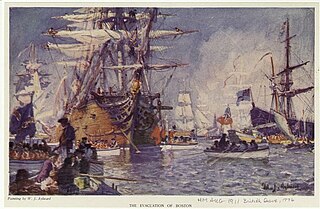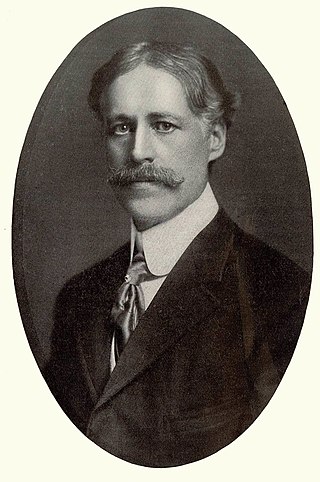
Thomas Ball was an American sculptor and musician. His work has had a marked influence on monumental art in the United States, especially in New England.

Evacuation Day is a holiday observed on March 17 in Suffolk County, Massachusetts and also by the public schools in Somerville, Massachusetts. The holiday commemorates the evacuation of British forces from the city of Boston following the siege of Boston, early in the American Revolutionary War. Schools and government offices are closed. If March 17 falls on a weekend, schools and government offices are closed on the following Monday in observance. It is the same day as Saint Patrick's Day, a coincidence that played a role in the establishment of the holiday.

Dorchester is a Bostonian neighborhood comprising more than 6 square miles (16 km2) in the City of Boston, Massachusetts, United States. Originally, Dorchester was a separate town, founded by Puritans who emigrated in 1630 from Dorchester, Dorset, England, to the Massachusetts Bay Colony. This dissolved municipality, Boston's largest neighborhood by far, is often divided by city planners in order to create two planning areas roughly equivalent in size and population to other Boston neighborhoods.

William Ordway Partridge was an American sculptor, teacher and author. Among his best-known works are the Shakespeare Monument in Chicago, the equestrian statue of General Grant in Brooklyn, the Pietà at St. Patrick's Cathedral in Manhattan, and the Pocahontas statue in Jamestown, Virginia.

South Boston is a densely populated neighborhood of Boston, Massachusetts, located south and east of the Fort Point Channel and abutting Dorchester Bay. It has undergone several demographic transformations since being annexed to the city of Boston in 1804. The neighborhood, once primarily farmland, is popularly known by its twentieth century identity as a working class Irish Catholic community. Throughout the twenty-first century, the neighborhood has become increasingly popular with millennial professionals.

Dorchester Heights is the central area of South Boston. It is the highest area in the neighborhood and commands a view of both Boston Harbor and downtown.

The Public Garden, also known as Boston Public Garden, is a large park in the heart of Boston, Massachusetts, adjacent to Boston Common. It is a part of the Emerald Necklace system of parks and is bounded by Charles Street and Boston Common to the east, Beacon Street and Beacon Hill to the north, Arlington Street and Back Bay to the west, and Boylston Street to the south. The Public Garden was the first public botanical garden in America.

Patrick Andrew Collins was an American politician lawyer who served as mayor of Boston and as a U.S. Representative from Massachusetts.

The Boston National Historical Park is an association of sites that showcase Boston's role in the American Revolution and other parts of history. It was designated a national park on October 1, 1974. Seven of the eight sites are connected by the Freedom Trail, a walking tour of downtown Boston. All eight properties are National Historic Landmarks.

The Fortification of Dorchester Heights was a decisive action early in the American Revolutionary War that precipitated the end of the siege of Boston and the withdrawal of British troops from that city.

Augustus Pearl Martin was an American politician and soldier from Massachusetts who served as the mayor of Boston, Massachusetts, in 1884. He also was a leading artillery officer in the Union Army during the American Civil War and was the leader of the state's Military Order of the Loyal Legion of the United States. He also served as a general in the Reconstruction era state militia.

Fort Independence is a granite bastion fort that provided harbor defenses for Boston, Massachusetts, located on Castle Island. Fort Independence is one of the oldest continuously fortified sites of English origin in the United States. The first primitive fortification was called "The Castle", placed on the site in 1634. It was rebuilt twice, then replaced around 1692 with a more substantial structure known as Castle William. It was abandoned by the British during the American Revolution, but the Americans renamed it Fort Adams and then Fort Independence. The existing granite fort was constructed between 1833 and 1851. Today it is preserved as a state park and fires occasional ceremonial salutes. Fort Independence was added to the National Register of Historic Places in 1970.

Roxbury Heritage State Park is a history-themed heritage park in the oldest part of Roxbury, a former town annexed in 1868 by Boston, Massachusetts. It is anchored by the Dillaway–Thomas House, a large colonial structure built in 1750 and thought to be the oldest surviving house in Roxbury. The location includes an adjacent 1-acre (0.40 ha) landscaped park with views of the Boston skyline, and is part of the Metropolitan Park System of Greater Boston.

John A. Fox (1835–1920) was an American architect. Fox practiced in Boston for fifty years and is best remembered for his works in the Stick Style.

Nick Collins is an American politician who currently serves as a member of the Massachusetts Senate, representing First Suffolk District. Collins serves as the Senate Chair of the Joint Committee on State Administration and Regulatory Oversight and the Senate Vice Chair of the Joint Committee on Community Development and Small Businesses. Additionally, he serves a member of the Senate Committee on Bills in the Third Reading, and a member on the Joint Committee's on Bonding, Capital Expenditures and State Assets; Mental Health, Substance Use and Recovery; and Public Service. He is a Boston resident and a Democrat. Elected into the Massachusetts House of Representatives in 2010, he served four terms in the House representing the 4th Suffolk District.
South Boston High School was a public high school located in South Boston, Massachusetts, United States. It was part of Boston Public Schools. The school closed in 2003, and its former facility is currently occupied by Excel High School.

The equestrian statue of Charles Devens is a public monument in Worcester, Massachusetts, United States. Located in front of the old Worcester County Courthouse in the Institutional District, the equestrian statue honors Charles Devens, who served as a general in the Union Army during the American Civil War and later served as United States Attorney General. The statue was designed by Daniel Chester French and Edward Clark Potter and was dedicated on July 4, 1906.

The Bigelow Monument is a public monument in Worcester, Massachusetts, United States. The monument, located in a small cemetery at the center of Worcester Common, honors Timothy Bigelow, a Patriot during the American Revolutionary War. The monument was dedicated on April 19, 1861, the 86th anniversary of the start of the war.

Commodore George Hamilton Perkins is a public memorial that stands on the grounds of the New Hampshire State House in Concord, New Hampshire, United States. The statue was designed by sculptor Daniel Chester French, with architect Henry Bacon designing the remainder of the public monument. It honors George H. Perkins, a New Hampshire native who had served as an officer in the United States Navy during the American Civil War. The statue was dedicated in 1902.

A statue of William Francis Bartlett stands inside the Massachusetts State House in Boston, Massachusetts, United States. The bronze statue was designed by sculptor Daniel Chester French and honors Bartlett, who had served as a general in the Union Army during the American Civil War. The statue was dedicated in 1904.






















